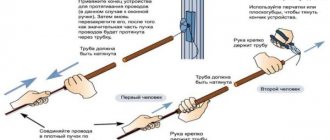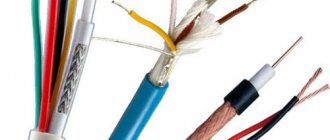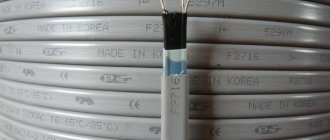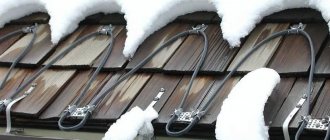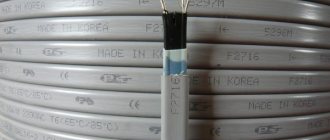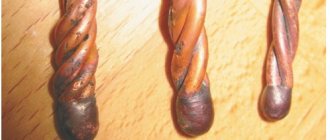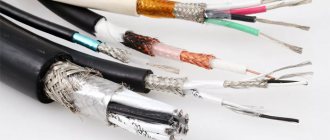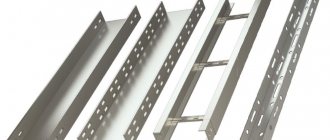When building a house without the help of specialists, not every owner takes into account climate changes throughout the year, so they forget to lay a heating cable for the water supply if it is installed above the freezing depth of the soil. To do this correctly, we will consider the types of wires, fastening methods, connection techniques and the procedure for thermal insulation. The article provides all this information, as well as a comparative analysis of cables, highlighting the advantages and disadvantages of each installation method.
Installation of cable along the pipe Source obustroeno.com
Features of the heating cable
The water supply cable is used to ensure that the water in the pipes remains in a liquid state even at subzero temperatures. In fact, it is a regular heating element that converts electrical energy into heat, taking into account the required temperature.
The design features that a heating cable for water supply must have are as follows:
- Multilayer , has several layers of insulation (according to GOST, at least 2).
- Increased flexibility . This allows installation of the cable on a pipeline of any configuration.
- Resistance to external influences and temperature changes.
- Immunity to aggressive conditions . Inside there should be a gasket in the form of a foil screen or copper braid. This avoids short circuits and neutralizes the magnetic field.
Internal filling of the cable Source koffkindom.ru
To choose the right heating cable, you should consider the main characteristics:
- Sufficient conductivity power for indoor installation per linear meter is 10 W/m.
- If the installation is carried out outdoors, then this figure should be increased to at least 20 W/m.
These nuances should be taken into account when choosing a wire in the same way as other indicators:
- Length . Not only the distance where the product will be laid is measured, but also the footage that will be required to insert the wires into the holes. A significant increase in length can lead to the fact that if the device is shorted or bent, the entire heating system will fail.
- Number of internal cores . Wires are produced in different thicknesses and have different conductor resistivities. The same diameter may differ in the internal filling, that is, in the number of cores.
Single-core and two-core cable Source sjevi.ru
- Section shape . Round – most often used for outer braiding. Flat - it is convenient to insert such a wire inside the pipe.
The maximum permissible temperature of the wire in the disconnected state should also be taken into account.
Options
We have found out the operating temperature range of this product. It should be said that in most cases the limit is 65 °C. The characteristics of a self-regulating heating cable are few. The main one is the dependence of power consumption on ambient temperature.
How does this heater work? As the temperature drops in any part of the pipe, the resistance between the cores decreases. More current flows in this place, so the heating temperature rises. For this reason, the manufacturer claims that the cable is self-regulating. But this is not entirely true. Heating adjustment occurs within small limits, as shown in the table:
| Ambient temperature (°C) | Power consumption (W/m) |
| 0 and below | 32.5 |
| +5 | 31.5 |
| +10 | 30 |
As you can see, the power decreases slightly, although at positive temperatures the heating should be turned off altogether. The characteristics of products from different manufacturers differ, but the decrease in power when heated does not exceed 15%. Let's figure out how to fix this situation further.
Types of cable
Before installation, it is important to study what heating wires are available and how to install them.
There are two types of cables: resistive and self-regulating.
The difference between them is that when an electric current passes through the cable, the resistive one heats up evenly along the entire length, while the feature of the self-regulating one is that the electrical resistance changes depending on the temperature. This means that the higher the temperature of the section of the self-regulating cable, the lower the current strength will be on it. That is, different parts of such a cable can each be heated to the desired temperature.
In addition, many cables are available with a temperature sensor and automatic control, which significantly saves energy during operation.
A self-regulating cable is more difficult to manufacture and costs more. Therefore, if there are no special operating conditions, then a resistive heating cable is often purchased.
Resistive
A resistive type heating cable for water supply has a budget price.
Cable differences Source teplina.rus
It is divided into several varieties, depending on the design features. Each of them has its own advantages and disadvantages:
| Cable type | pros | Minuses |
| Single-core | The design is simple. It has a heating metal core, copper shielding braid and internal insulation. On the outside there is protection in the form of an insulator. Heats up to a maximum of +65°C. | It is inconvenient for heating pipelines: both opposite ends, which are far from each other, must be connected to the current source. |
| Two-core | It has two cores, each of which is separately insulated. The additional third core is bare, but all three are covered by a foil screen. The external insulation has a heat-resistant effect. It heats up to a maximum of +65°C. | Despite the more modern design, it is not much different from a single-core element. The operating and heating characteristics are identical. |
| Zonal | There are independent heating sections. The two wires are insulated separately, and a heating coil is located on top. The connection is made through contact windows with conductive conductors. This allows heat to be created in parallel. | No shortcomings were found, if you do not take into account the price tag of the product. |
Resistive wires of different types Source yandex.net
Most buyers prefer to lay the wire “the old fashioned way” and purchase a wire with one or two cores.
Due to the fact that a cable with only two cores can be used to heat pipes, the single-core version of the resistive wire is not used. If the owner of the house unknowingly installed it, this threatens to short circuit the contacts. The fact is that one core needs to be looped, which is problematic when working with a heating cable.
If you install the heating cable on the pipe yourself, then experts advise choosing a zonal option for external installation. Despite the peculiarity of the design, its installation will not cause serious difficulties.
Additional features and advantages of zonal cables: stable power, you can cut the product and connect to the power source due to the presence of an end section. Another important nuance in single-core and double-core designs: on sale you can find already cut and insulated products, which eliminates the possibility of adjusting the cable to the optimal length. If the insulating layer is damaged, the wire will be useless, and if damage appears after installation, the entire system will need to be replaced. This disadvantage applies to all types of resistive products. Installation work of such wires is not convenient. It is also not possible to use them for laying inside the pipeline - the head of the temperature sensor gets in the way.
Wire design Source otdelkaexp.ru
See also: Catalog of companies that specialize in electrical engineering.
Another important nuance in single-core and double-core designs: on sale you can find already cut and insulated products, which eliminates the possibility of adjusting the cable to the optimal length. If the insulating layer is damaged, the wire will be useless, and if damage appears after installation, the entire system will need to be replaced. This disadvantage applies to all types of resistive products. Installation work of such wires is not convenient. It is also not possible to use them for laying inside the pipeline - the head of the temperature sensor gets in the way.
Self-regulating
Self-regulating heating cable for water supply with self-regulation has a more modern design, which affects the duration of operation and ease of installation.
The design provides:
- 2 copper cores in a thermoplastic matrix;
- 2 layers of internal insulating material;
- copper braid;
- external insulating element.
It is important that this wire works great without a thermostat. Self-regulating cables contain a polymer matrix. When turned on, carbon is activated, and when the temperature rises, the distance between its graphite components increases.
Self-regulating cable Source moydomik.net
On a note ! Self-regulating wire is more expensive, but these costs will pay off in the future. Pipes can be heated more intensely, using less electricity.
Eastec SRL 10-2 CR
Photo: https://market.yandex.ru
Along with the cable, the package includes everything necessary for connecting to the electrical network: connection set, input coupling, power cord with plug. The food coating does not emit harmful substances, which guarantees safety of use in the water supply system. Cable power is 10 W, minimum bending radius is 25 mm. If necessary, the model can be easily divided into lengths from 20 to 120 centimeters. It features minimal energy consumption and is guaranteed to last more than 15 years.
EASTEC MICRO 10 – CTW, SRL 10-2CR M=10W, heating cable with food sheath
Advantages:
- convenient installation
- extended equipment
- high strength
- non-toxic materials
Flaws:
- low-power
#Top 10
Read us first - add the site to your favorite sources.
Add a comment
{"commentics_url":"\/\/express-novosti.ru\/comments\/","page_id":1363532,"enabled_country":false,"enabled_state":false,"state_id":0,"enabled_upload": false,"maximum_upload_amount":3,"maximum_upload_size":5,"maximum_upload_total":5,"securimage":true,"securimage_url":"\/\/express-novosti.ru\/comments\/3rdparty\/securimage\ /securimage_show.php?namespace=cmtx_1363532″,”lang_error_file_num”:”\u041c\u0430\u043a\u0441\u0438\u043c\u0443\u043c %d \u0444\u0430\u0439\u043b\u043e\ u0432\u043c\u043e\ u0436\u0435\u0442 \u0431\u044b\u0442\u044c \u0437\u0430\u0433\u0440\u0443\u0436\u0435\u043d\u043e.","lang_error_file_size":"\u041f\u043e \u0436\u0430\u043b\ u0443\u0439\u0441\u0442\u0430, \u0437\u0430\u0433\u0440\u0443\u0437\u0438\u0442\u0435 \u0444\u0430\u0439\u043b \u0440\u0430\ u0437\u043c\u0435\u0440\u043e \u043c \u043d\u0435 \u0431\u043e\u043b\u0435\u0435 %d MB.","lang_error_file_total":"\u041e\u0431\u0449\u0438\u0439 \u0440\u0430\u0437\u043 c\u0435\u0440\ u0432\u0441\u0435\u0445 \u0444\u0430\u0439\u043b\u043e\u0432 \u0434\u043e\u043b\u0436\u0435\u043d \u0431\u044b\u0442\u044c \ u043d\u0435\u0431\u043e\u043b\ u0435\u0435 %d MB.","lang_error_file_type":"\u041c\u043e\u0436\u043d\u043e \u0437\u0430\u0433\u0440\u0443\u0436\u0430\u0442\u044c \u0442\u0 43e\u043b\u044c ""lang_text_loading":" u0437\u043a\u0430 ..","lang_placeholder_state":"\u0420\u0435\u0433\u0438\u043e\u043d","lang_text_country_first":"\u0421\u043d\u0430\u0447\u0430\u043b\u0430 \u0432\u044b\u04 31\u0435 \u0440\u0438\u0442\u0435 \u0441\u0442\u0440\u0430\u043d\u0443″,”lang_button_submit”:”\u0414\u043e\u0431\u0430\u0432\u0438\u0442\u04 4c","lang_button_preview":" \u041f\u0440\u0435\u0434\u0432\u0430\u0440\u0438\u0442\u0435\u043b\u044c\u043d\u044b\u0439 \u043f\u0440\u043e\u0441\u043c\u 043e\u0442\u0440″,”lang_button_remove ":"\u0423\u0434\u0430\u043b\u0438\u0442\u044c","lang_button_processing":"\u041f\u043e\u0434\u043e\u0436\u0434\u0438\u0442\u0435..."}
Installation methods
Installation work can be carried out in two main ways:
- When the wire is attached to the outside of the pipe.
- When - installed inside it.
Both methods have their own nuances. When choosing a cable laying method, you should also not forget about additional thermal insulation of the pipeline.
External cable installation
You can install the cable outside the pipe along it or around it using the ring (spiral) method.
Linear method
More often, wire installation is carried out linearly, when the cable for heating the water pipe is attached from below. Despite its simplicity, the method has its advantages, the main of which is protection. In this case, the risk of breaking the integrity of the wiring will be minimized, and the heating element will not suffer from mechanical damage from above. The electrical cable should be secured at the bottom. The fixation must be strong. Then the frost will not grab the water supply in case of a sharp drop in temperature.
Fastening along the pipe Source prom.st
On a note ! For fastening it is better to use: aluminum tape. It will increase heat transfer.
Ring method
The spiral method allows you to place the conductor along the outer radius of the pipe. This option is necessary for areas with low temperatures in winter. Due to the circular circulation, the water supply heats up better. The only downside of this method is that it requires a longer cable. To increase heating and properly secure the product, it is important to observe an intersection step no more than 5 cm.
On a note ! If there is a hard-to-reach area, then you can hug it with a small allowance. It is important to wrap the loops in the opposite direction.
Ring winding of heating cable Source www.dobroeteplo174.ru
Installation of individual components when laying cables outside the pipe
If you need to install the cable on separate metal supports, more material will be required to provide better thermal insulation. For this, only a self-regulating wire is used. Difficulty may arise from installing a temperature sensor, which will prevent the structure from overheating. It should be placed at the point where the heating rate is lowest. It is important to maintain the distance of the sensor from the cable line: no closer than a meter.
On a note ! The surface where the device will be installed is first glued with aluminum tape.
Connection and thermal insulation
The connection technique is universal, regardless of which wire is used, but there are nuances. The installation of the heating cable is completed by insulating the ends and connecting them to devices and sensors. To work you need to use the following equipment:
- knife;
- pliers;
- side cutter;
- construction hairdryer
First you need to prepare the cable. This will require additional terminals that come with the wire or pipe. Inside the sleeve has a special heat-shrinkable layer that improves the quality of the connection. Instead of a terminal, a special plug can be used. Only after this the end coupling is installed. To do this, first cut off a few centimeters of the outer insulation, then remove the braid, string the sleeve and heat it with a hair dryer so that shrinkage is successful. To be sure, the terminal should be clamped for a few seconds with pliers.
An example of cable installation inside a water supply system Source www.ingeneriya.ru
Bottom line
Heating cables are convenient because they allow different installation options, depending on the wishes of the consumer. All that remains is to choose a system that has the appropriate characteristics to get the job done.
The optimal option is considered to be inside the pipe, although its characteristics are not inferior to external installation. With short pipes, installation problems practically do not arise at all. Difficulties arise only if it is necessary to strengthen and improve pipes that are already dug into the ground.
Nuances of installation work
When the wire is securely fastened inside or outside, it is important to take care of the insulation of the end of the conductor. Experts recommend using heat shrink tubing. This product will perfectly protect the conductors from moisture, which will reduce the risk of short circuits and repair work. We must not forget that the heating part must be connected to the “cold” part.
Connecting wires Source termodar-64.ru
Tips and recommendations from experienced craftsmen:
- If you use two methods of laying wires inside and outside the pipe at once, you can increase the rate of water heating several times, but this will require additional installation costs.
- Heating water pipes with a self-regulating heating cable will allow you to ignore warm sections and direct the current to cold places. It is allowed to be cut, so there will be no problems in installation even in hard-to-reach places. The cable length does not affect heat transfer.
- Resistive wire is half the price, but its service life is much shorter. If a regular two-core cable was installed, you should prepare for the fact that in 5-6 years it will have to be replaced.
- The braid on the wire serves to ground it. You can skip this stage of work, but it is better to become familiar with grounding methods.
Video description
How to ground a water supply is shown in the video:
- Most often, for self-installation, a linear cable laying method is chosen.
- The level of heat transfer directly depends on what pipes are installed in the room. For plastic pipes, this figure will not be high, which means that when installing a heating cable for a water supply system, you will need to wrap the pipes with aluminum foil.
- Before attaching a cable to the outside of a metal pipe, it is important to ensure that there is no rust. If there is one, it requires cleaning and treatment with a special antiseptic. If this is neglected, there is a risk of damage to the insulation in the future.
- If fastening is carried out from the outside, then the distance between the insulating bundles should not be more than 30 cm. If you take a wider step, then after a while the fastening elements will separate.
- In practice, some craftsmen pull two wires at once to increase the heating rate. It is important that there is a small distance between the cables.
- For fastening to plastic, it is better to use special clamps.
Fastening with clamps and thermal insulation in section Source yandex.net
- If you decide to twist the wire in a spiral, then initially the pipe is wrapped with metallized tape.
- To fix the insulation, it is better to use special ties. They can be purchased at any hardware store.
- It is necessary to completely isolate the temperature sensor from the electrical cable to eliminate the risk of short circuit and fire. To do this, it is necessary not only to maintain a distance between these devices, but also to make the insulating gasket with a special material.
- Heating the pipelines with a heating cable using a thermostat will ensure constant temperature maintenance. It is better to install this device next to the electrical panel or directly in it. It would not be superfluous to install an RCD.
Wire with thermostat Source www.elektrikaup.ee
Anti-icing system design
As already noted, the cable is the main (heating) element of the anti-icing system for gutters and roofs. But not the only one. To assemble a fully functioning system, the following components are used:
- heating cable;
- supply wire used to supply voltage (it does not heat up);
- fasteners;
- couplings;
- power unit;
- RCD;
- thermostat.
The productivity of the heating system largely depends on the thermostat. This device allows you to turn heating sections (cable) on and off, limiting their operation in a pre-fixed range of weather conditions. The thermostat can determine their value using special sensors that are installed in places of greatest accumulation of water.
A conventional thermostat is characterized by the presence of a temperature sensor. As a rule, for small systems, a dual-range thermostat is used with the ability to adjust the cable on and off temperature.
A specialized thermostat, called a weather station, controls the operation of the system more effectively. It contains several sensors that record not only temperature, but also a number of other parameters that affect the formation of ice. For example, air humidity, the presence of residual moisture on pipes and roofing. Weather stations operate in the mode of established programs and allow you to save up to 80% of electricity.
